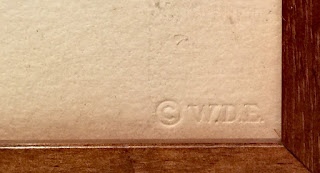Original hand painted and hand inked production animation cel of Snow White; Set on an airbrushed Courvoisier background from "Snow White and the Seven Dwarfs," 1937, Walt Disney Studios; Size - Snow White: 5 1/2 x 3 1/4", Image 7 1/4 x 7 1/4", Frame 21 x 19 1/2"; Framed using a gold and cherry wood frame, four mats, gold wood fillet, custom engraved brass title plaque, and plexiglass.
Development on Snow White and the Seven Dwarfs began in early 1934, and by June Walt Disney announced to The New York Times the production of his first feature, to be released under Walt Disney Productions. Before Snow White and the Seven Dwarfs, the Disney studio had been primarily involved in the production of animated short subjects in the Mickey Mouse and Silly Symphonies series. However, Disney hoped to expand his studio's prestige and revenues by moving into features, and he estimated that Snow White and the Seven Dwarfs could be produced for a budget of $250,000 (this was ten times the budget of an average Silly Symphony).
Snow White and the Seven Dwarfs was to be the first full-length cel animated feature in motion picture history, and as such Walt Disney had to fight to get the film produced. Both his brother and business partner Roy Disney, as well as his wife Lillian attempted to talk him out of it. The Hollywood movie industry mockingly referred to the film, while is was in production, as "Disney's Folly." Disney ended up having to mortgage his house to help finance the film's production, which would eventually ran up to a total cost of $1,488,422.74; an absolutely massive sum for a feature film in 1937!
After a long and difficult four years, on January 13, 1938, Snow White and the Seven Dwarfs made its New York premiere at Radio City Music Hall. The film ran for five weeks in a row, the first motion picture to do so, and it could have played longer if not for prior commitments of the venue. It was to be the theatres' most successful engagement in all of the 1930s. The film was loved by everyone and Disney, along with his animation team, had managed to make an animated film that the audience would believe! The crowd would be sad and cry when Snow White bit the apple and was placed in a glass casket; and they would laugh, smile, and be happy during the song and dance numbers with the Dwarfs.
A
large number of actresses auditioned for the voice of Snow White. Walt
Disney listened to each audition in his office while the actress
performed in another room, without any knowledge of the actress'
appearance or reputation. This would insure that he would only judge
based on the sound of the voice. According to later accounts, most of
the voices Disney felt, did not sound young enough. Eventually, in
September of 1935, Adriana Caselotti was chosen for the voice of Snow
White. Caselotti was eighteen at the time and made her coloraturo
soprano sound younger, knowing that the character was intended to be 14
years old. In recording sessions Caselotti found difficulty in the line,
"Grumpy, I didn't know you cared"; instead of "didn't", Caselotti was
only able to say "din". After rehearsing the line many times, Walt
Disney eventually said "Oh, the heck with..." and "din'" remained in the
final film.
Snow
White's design was supervised by Grim Natwick, an animator who had
previously developed and worked on Betty Boop at Fleischer Studios. It
is interesting to note that early designs for the Snow White resemble
Betty Boop, and some appear to be caricatures of famous actresses of the
time. As development continued, Snow White became more and more
lifelike. Another animator, Hamilton Luske's first designs for Snow
White depicted her as a slightly awkward, gangly teenager. However, Walt
Disney had a different idea in mind; he wanted Snow White to be older,
and more realistic-looking. This was achieved by the use of live-action
references for the animators. Also, in order for Snow White to better
relate onscreen to the seven Dwarfs, it was decided that her head be
slightly larger than normal. In addition, the women in the animation
studio's ink and paint department felt that Snow White's black hair was
too unnatural and harsh, so they drybrushed whisps of light grey over
the top of each and every cel.
This is a perfect portrait image of the first Disney Princess, Snow White. She is beautifully centered, eyes and mouth are open, and her hands are folded upon her lap. She is placed on an hand airbrushed Courvoisier background. The cel is custom framed and would be a great addition to any animation art collection!
#SnowWhite #Doc #Bashful #Dopey #Happy #Sneezy #Sleepy #Grumpy #Disney #WaltDisney #PintoColvig #VladimirTytla #BillTytla #MarcDavis #GrimNatwick #animation #FrankChurchill #HamiltonLuske #AdrianaCaselotti #animationdrawing #productiondrawing #animationart #untitledartgallery #cel #CourvoisierGalleries #CourvoisierGallery #Courvoisier #Witch #EvilQueen #OldHag #Huntsman #animationcel #sevendwarfs #dwarfs #ArtBabbit #OllieJohnston #FrankThomas #ShamusCulhane #FredMoore #LucilleLaVerne #KeySetup #productionbackground #RadioCityMusicHall #JoeGrant



























